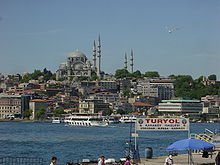Cultural achievements[edit]
Under Suleiman's patronage, the Ottoman Empire entered the golden age of its cultural development. Hundreds of imperial artistic societies (called the اهل حرف Ehl-i Hiref, "Community of the Talented") were administered at the Imperial seat, the Topkapı Palace. After an apprenticeship, artists and craftsmen could advance in rank within their field and were paid commensurate wages in quarterly annual installments. Payroll registers that survive testify to the breadth of Suleiman's patronage of the arts, the earliest of documents dating from 1526 list 40 societies with over 600 members. The Ehl-i Hiref attracted the empire's most talented artisans to the Sultan's court, both from the Islamic world and recently conquered territories in Europe, resulting in a blend of Arabic, Turkish and European cultures.[49] Artisans in service of the court included painters, book binders, furriers, jewellers and goldsmiths. Whereas previous rulers had been influenced by Persian culture (Suleiman's father, Selim I, wrote poetry in Persian), Suleiman's patronage of the arts had seen the Ottoman Empire assert its own artistic legacy.[50]
Suleiman himself was an accomplished poet, writing in Persian and Turkish under the takhallus (nom de plume) Muhibbi (محبی, "Lover"). Some of Suleiman's verses have become Turkish proverbs, such as the well-known Everyone aims at the same meaning, but many are the versions of the story. When his young son Mehmed died in 1543, he composed a moving chronogram to commemorate the year: Peerless among princes, my Sultan Mehmed.[51][52] In addition to Suleiman's own work, many great talents enlivened the literary world during Suleiman's rule, including Fuzuli and Baki. The literary historian E. J. W. Gibb observed that "at no time, even in Turkey, was greater encouragement given to poetry than during the reign of this Sultan".[51] Suleiman's most famous verse is:
Suleiman also became renowned for sponsoring a series of monumental architectural developments within his empire. The Sultan sought to turn Constantinople into the center of Islamic civilization by a series of projects, including bridges, mosques, palaces and various charitable and social establishments. The greatest of these were built by the Sultan's chief architect, Mimar Sinan, under whom Ottoman architecture reached its zenith. Sinan became responsible for over three hundred monuments throughout the empire, including his two masterpieces, the Süleymaniye and Selimiye mosques—the latter built in Adrianople (now Edirne) in the reign of Suleiman's son Selim II. Suleiman also restored the Dome of the Rock in Jerusalem and the Jerusalem city walls (which are the current walls of the Old City of Jerusalem), renovated the Kaaba in Mecca, and constructed a complex in Damascus.[54]


No comments:
Post a Comment